I arrived at the Koelmesse this morning, headed up the familiar steps of the South Entrance and made my way to Leica’s huge booth, again occupying the entirety of Hall 1.The place is enormous with areas for each system, press areas, dealer areas, a sport optics watch tower and an equally massive gallery and event space located at the back of the booth.
By the time I arrived, the press conference was just underway and after an unveiling of the impressive gallery exhibition which we were seated in the midst of, Dr. Kaufmann took to the stage and presented some of the headlining new products with the glee of a proud parent. After attending many such launch events over the years, I know that he loves playing the Steve Jobs role and showing off what has been under wraps for so long with a casual but charismatic flair.
Leica has announced a dizzying array of new products, a record for them, that we all would have been sitting there for over an hour if Kaufmann were to introduce each one. Instead, he presented them fairly rapid fire with just a little tease for each.
The message from Kaufmann was clear: Leica is celebrating its 100th anniversary of making cameras and its 60th anniversary of the first M camera, the iconic M3. And, to commemorate these events, Leica would once more show the photography world that they will continue to innovate, continue to lead and continue to take some pretty big risks.
This is nothing new for Leica. Two years ago, they came up with a crazy idea to produce a digital camera that only shoots B&W. After the initial knee-jerk reactions, the camera proved (and still continues to prove) that this idea wasn’t only not crazy, but in fact, genius. The M Monochrom produces quality that rivals that of 4×5 B&W film. For many, seeing was believing. For others, being educated on the merits of no interpolation and no demosaicing won them over.
The Leica T was another, and more recent, risky move. With its competitors copying their rangefinder style with the advent and expanding market of EVIL/mirrorless cameras, Leica went the completely opposite direction, creating something so modern and clean that it set itself apart. They introduced new concepts like the first unibody aluminum constructed camera and an intuitive 4” touchscreen interface, then backed up the phenomenal design with real Leica image quality.
Now, Leica is again rolling the dice with a digital camera…with no LCD screen or menus of any kind. More craziness? Perhaps, but then again, maybe not. The M Edition 60 is a thing of absolute beauty. And while it even just looks amazing, I was able to hold one for serveral minutes before it was whisked away. Everyone wanted a chance to possess this part digital anomaly, part work of art.
The M Edition 60 is based on the current Leica M-P (Typ 240), but feels denser due to the solid-milled stainless steel construction. The Audi design collaboration features a unique textured, embossed gray leather cladding, all stainless steel control elements and perhaps most unique, no rear LCD. In lieu of other controls, just the essentials remain: a power switch with single advance only, a top shutter speed dial, a function button on the top deck to check remaining battery and SD card capacity and a very classy ISO dial on the rear.
The camera takes clean lines to the extreme. There aren’t even any strap lugs; for that, you’ll have to use the included leather and stainless steel camera protector with a carrying strap. The frame lines are still LED illuminated, but only in red and the camera only shoots in uncompressed DNG. There is also a sensor cleaning mode, which can be activated by toggling the power switch past the off position. Even the bottom plate is clean. There is no externally visible catch. Leica really wanted to strip away the digital-ness of this camera. Under the top plate, where you’d normally find the electronic connector for the handgrip, there’s…. Just a blank cover.
The camera might even be worth it, just to get the included stainless steel 35mm Summilux ASPH FLE. Best. Aperture ring. Ever. I want all my M lenses to have this feel. The wider grip and smoother action are just incredible. Even the focusing tab got a little make-over. It offers a lower profile and is also finished in stainless steel. On the front of the lens, you have the choice of keeping it simple with a finishing ring, or screwing on the matching circular lens shade.
As I already mentioned, the camera has a considerable heft, and defines quality construction. Every line. Every edge. Every curve. Just perfect. Everything is deliberate and minimized to create perhaps the most pure M design Leica has ever produced. Das Wesentliche, indeed. Little touches like reducing the height of the top plate, squaring off the secondary light meter window and hiding a little SD card activity light in the pattern of the leather cladding, all contribute to the feel of this unadulterated photography tool.
I’ll be totally honest here. When rumors were circulating about a digital M sans screen, I thought this sounded pretty nuts and assured myself that I would never want to use such a camera. I mean, isn’t the point of digital to have instant feedback, live view composition and metering? Well…now, that I’ve handled it, my will has weakened considerably. As I sat there, turning the camera over in my hands, appreciating every nuance, I was easily able to imagine using this gorgeous piece as my daily shooter. The 600 piece limited edition will sell for $18,500, which is about $6,000 more than a comparable M (Typ 240) and 35mm Lux FLE. Pick up the camera for just five minutes and the price will seem like a downright bargain. Seriously. Or, compare it to the M9 Titan set, which was limited to 500 pieces and sold for $26,500, then years later for north of $35,000 on the secondary markets.
If you started in photography shooting film like I did at the tender age of 7, you might recall that little thrill you got, from squeezing off the shutter, knowing that you nailed the shot without having to see it on a screen, then later, the ultimate satisfaction of throwing down a freshly developed stack of slides on the light box. Do you remember marveling at the fruits of your labor, as you peered through your loupe, basking in the subtle white glow of the light table? Perhaps this 60th anniversary M could bring this feeling back, except now you get to bask in the glow of your 27” monitor and revel in the details afforded by the 1:1 magnification in Lightroom, rather than that of a 5x loupe.
So, yes, the M Edition 60 defies conventional wisdom regarding digital cameras. Maybe the M60 goes beyond reason and indeed rekindles that old nervous excitement that shooting with film brought. Like a return to simpler times or a remembrance of an era too soon forgotten.
Sure, you could just shoot film and spare yourself the expense of going for a special edition set. In fact, Leica simultaneously launched the M-A, a true analog camera in every sense of the word. The M-A is basically an M-P film camera with a few important modifications. First, there is no light meter or battery. And, there is a handy ISO marker dial on the back, echoing the design of the M Edition 60. The marker actually has a very useful detail. There are two sides of the inner dial, one black and one red. This is to indicate whether you have color or B&W film loaded, just in case you put the camera away for a while and forget. The Leica M-A is available in both black chrome and silver chrome for $4,750.
While not really a new announcement at the show, Leica was also showing off the very recently released Leica M-P (Typ 240), which adds a 2GB buffer for the ability to capture more frames in rapid succession, sapphire LCD cover glass, a frame-line preview lever and a de-branded look. You can read more about the M-P here.
The four-lens Summarit line was redesigned and reintroduced, still comprised of a 35, 50, 75 and 90mm lenses. The aperture has been slightly improved from f/2.5 to f/2.4 and more importantly the minimum focus distance on both the 75 and 90mm has been reduced to 0.7 and 0.9m respectively. This puts the 75mm Summarit in same category as the 75mm APO-Summicron ASPH for reproduction ratio. Of course, you could always just use the fairly recent Macro-Adapter M. I had a nice chat with head of optics Peter Karbe, who was kind enough to whip out his iPad and show me some truly outstanding macro photographs he’s been taking with the M (Typ 240) and the adapter. Naturally, he tends to use the Noctilux wide open for an ethereal look. So, not only is Peter a legendary lens designer, he’s also quite the accomplished photographer. This is, of course, not unusual to find at Leica. Most, if not all, product and optics designers are also avid photographers, using their designs in the real world for their own pictures.
But, back to the Summarits…. The new designs are really very, very nice. The silver versions look quite stunning, especially when mounted on a silver body. Great combo.
I had the opportunity to speak at some length with M Product Manager, Jesko von Oeynhausen. The transcript of our interview is below.
Let’s first dive into the M-P (Typ 240). The M-P seems to be a big hit. Has the camera's reception been up to your expectations?
Not having the red dot is popular. The 2GB buffer was a nice surprise for users, offering additional functionality. Having a faster camera is always appreciated. With the larger buffer, you are always ready to shoot.
People love the sapphire glass. Even though the Gorilla glass of the M (Typ 240) is very durable, customers really asked for the sapphire class quite frequently. And, the 3″ sapphire is even more costly than the smaller 2.5″ one used on the M9-P.
It's amazing that with the larger buffer, you can actually get almost three times more images in a burst. How many photographers were asking for a larger buffer in the M?
The increase in images will vary with the picture content. If there is a lot of sharpness across the frame, the advantage will be less. With more areas out of focus, more as they compress better.
Of course, photographers asked for a “faster” camera, they didn't ask *how* we do it. Changing out the RAM chip seemed to be the easiest way to accomplish this. The M 240 is much faster than the M9 and also has larger files, so the buffer fills quickly.
Initially, when we developed the M 240, the supply of 2GB RAM was not readily available in good quantities. So, this was always a goal of ours, to incorporate it when the supply chain become more mainstream.
Should we take the decision to add back the frame-line preview level as a sign of things to come on future M models? Have users specifically asked for this to return after the M-E and M (Typ 240)?
We never received any serious complaints about the frame line preview lever. But, we felt that putting it back was in line with the style of the M-P. Perhaps on some future models, this will remain. Others may not.
Tell me the story of the screw.
Many people were surprised why the screw was so large. There was a technical reason for this. With the M 240, we redesigned the rangefinder to make it more accurate in order to meet the increased demands of the higher resolution sensor. This reconstruction needs a larger opening in the front of the top cover for the final adjustment and calibration in manufacturing. The larger diameter opening needs a larger screw.
Okay, now the main attraction. Let's talk about the M Edition 60.
The decision to come out with a digital camera with no screen in 2014 is a pretty bold move. How has the response been so far to the M 60th Anniversary?
This idea was proposed quite frequently by users over the years. Professionals even missed the experience of not having to share their images right away. On shoots, clients would expect to see images on the LCD right away, rather than waiting for the photographer to deliver these.
Of course, there is an emotion aspect as well. Everyone who has shot film knows the excitement you get from seeing your images after the shoot. So, while this isn't a technological advantage, it is an emotional one.
And it makes you think more. It's a more quiet and contemplative process. Nothing gets in the way of the photograph.
It's just the essentials of what you need. This is the cure for too much complication.
Also, since we developed the M-A at the same time, I get reacquainted with shooting film. It was so refreshing to use analog again. Minimal controls and you really have to think about what you are going to take a picture of ahead of time.
What is the M button on top used for?
This is to tell basic info in the viewfinder. Press once for battery percentage remaining. Press once more for number of photos remaining on SD card.
You know, a lot of people questioned Leica's sanity of coming our with a digital camera that could only shoot B&W and it ended up being a huge success. Do you guys know something the rest of us don't, about what photographers really want?
Everyone is doing the wrong thing, putting too much into their cameras. We are going the other way. We are in close contact with our customers and try to make products for them. This sounds obvious and maybe a little cliché, but it's true. For instance, we do surveys to find out the features that our customers want. Many of these we may not have considered. So, we try to incorporate them into future products.
And equally important, all people working at Leica, everyone is personally passionate about the cameras they make. And if you have passion, you know you are doing the right thing.
And of course, since we use these cameras ourselves, we understand what works and what doesn't.
Even though there is no rear LCD, does a user have the option to use an EVF2?
No, this would compromise the concept. If you would put the EVF on, users would then expect more menus and other complications.
Why are there no strap lugs?
There is a special carrying system. The protector has a strap. The camera has such a clean form, the lugs would disrupt the concept.
Why isn't the M 60 thinner as there is no LCD? is there a technical limitation or does it have more to do with already having certain parts and accessories available?
It's still based on the M240, with the electronics and mechanicals. The thickness of the top plate did not change as it still accommodates the viewfinder and rangefinder, but the body is a little thinner. The tech specs don't tell the whole story.
How involved was Audi Design?
We have a long standing relationship with Audi, for many years now. They actually helped design the M240 as well.
Because it's a special edition we wanted to showcase something really special, so the design reflects this.
Okay, moving on to other M subjects….
There were lots of rumors regarding a new M Monochrom. Personally, the quality of the images from the Monochrom continues to amaze me.
From a quality perspective, there is no need for improvement.
Tell me a bit more about the redesigned Summarit line.
We redesigned the outer parts, but the optics are based on the existing lenses. We wanted to create a design that better matched the current design language.
And, we improved everything possible that we could on the optics as well. Close focus has been improved and we worked on some technical specification so that it was possible to achieve f/2.4 aperture.
My favorite lens is the 50mm. It just looks great on the M240
The design of the 35mm now shows that it is an ASPH.
The previous 35mm Summarit actually always had an aspherical element in it.
Has imaging performance been improved in addition to the bump in aperture?
Imaging performance will be the same as that of the previous Summarits, which was excellent. Even with the close focusing change, there is no loss of quality.
The styling of the lenses is really quite nice. Will we see more of this kind of design language in new lenses, like how the latest generation of wide angle lenses led to a screw-on metal shades instead of clip-on plastic ones?
Yes, for instance, all new lenses will feature writing on the front of the lens right-side-up rather than wrapping around. The metal lens hood design also allows you to use one lens cap, both with the hood attached and with just the finish ring attached without the hood. It is really quite nice.
Will we see a production 28mm Summilux ASPH?
In time. We need to make new tooling for mass production, rather than just a hundred special edition units that were hand-made for the M Edition 100 Set.
Thanks Jesko.
My pleasure, David.
During our discussion, Director of Product Management Stefan Daniel poked his head into our press room. He reiterated Leica’s focus on eliminating all unnecessary elements and focusing on Das Wesentliche, the essentials. I asked Stefan if the flood of new products was a coincidence or a planned effort to coordinate with the 60th anniversary of the M and the 100th anniversary of Leica photography. He looked me square in the eye and said, “Um. No.” Stefan continued, “This was quite on purpose. Of course we wanted to show lots of products, but also products that are true to the roots of Leica. The M-A, the M 60, these are the ultimate statements that speak to the uncomplicated nature of M photography.”
After the show, Leica held a “small” event in the adjacent gallery space. First they honored legendary photographer Thomas Heopker with the Leica Hall of Fame Award. He joined Dr. Kaufmann on stage as they projected a small sampling of his long career spanning from his iconic images of Muhammad Ali to poignant images from 9/11. In addition to the usual prize of a camera, he was also awarded a check of 25,000 Euros. Apparently there was some poor planning with the check and CEO Alfred Schopf had to handwrite and sign a program. According to Kaufmann, while not fancy, it was perfectly legal. I’m sure Hoepker was just pleased to be getting the surprise sum.
After a break for Kölsch, champagne and hors d’ oeuvres, British pop and jazz star Jamie Cullum got up to jam out with his band. Behind him, Leica M images that he shot on his last tour were projected on the big screen. In fact, in the music-theme exhibit, Jamie’s work is among that of other notable photographers.
By 10:30pm I had about enough and headed back to settle in to a relaxing evening of writing.
After an all-to-brief rest, I’ll be heading back to the show tomorrow for more hands-on and more interviews. If you have any questions that you’d like to ask, please post them here as comments or in the forum.

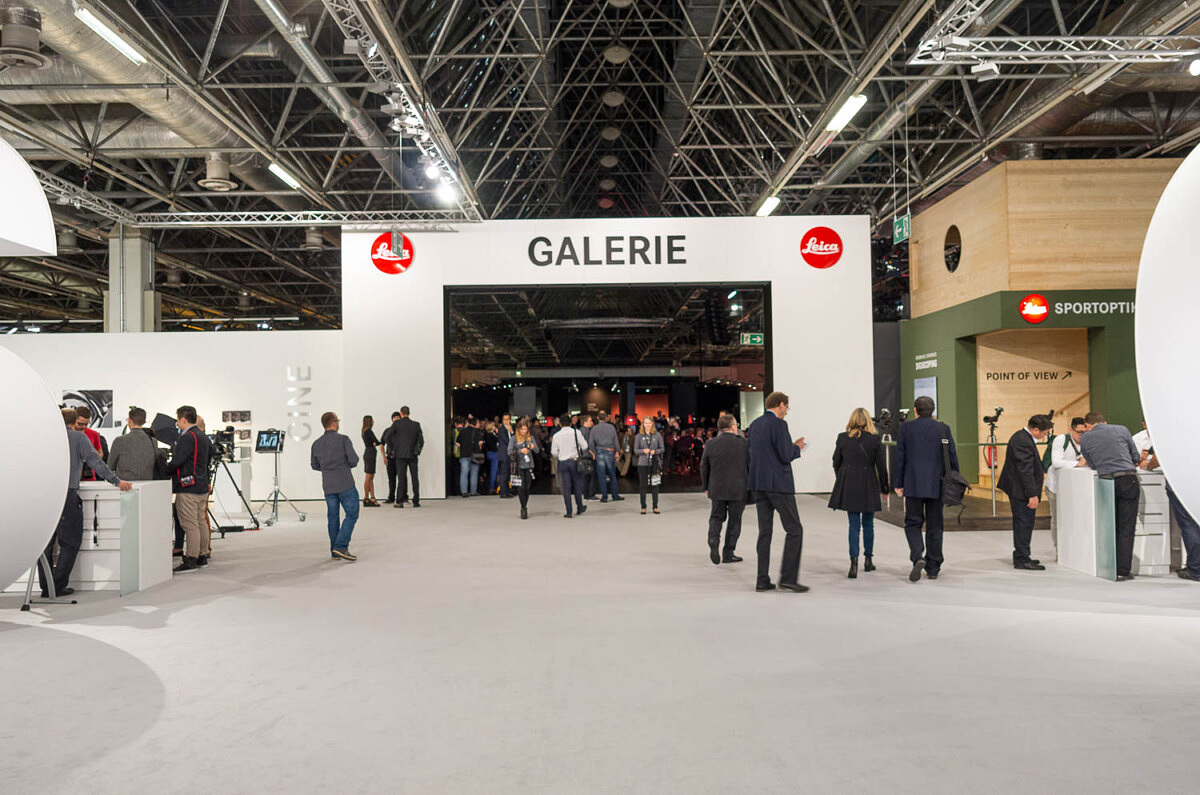


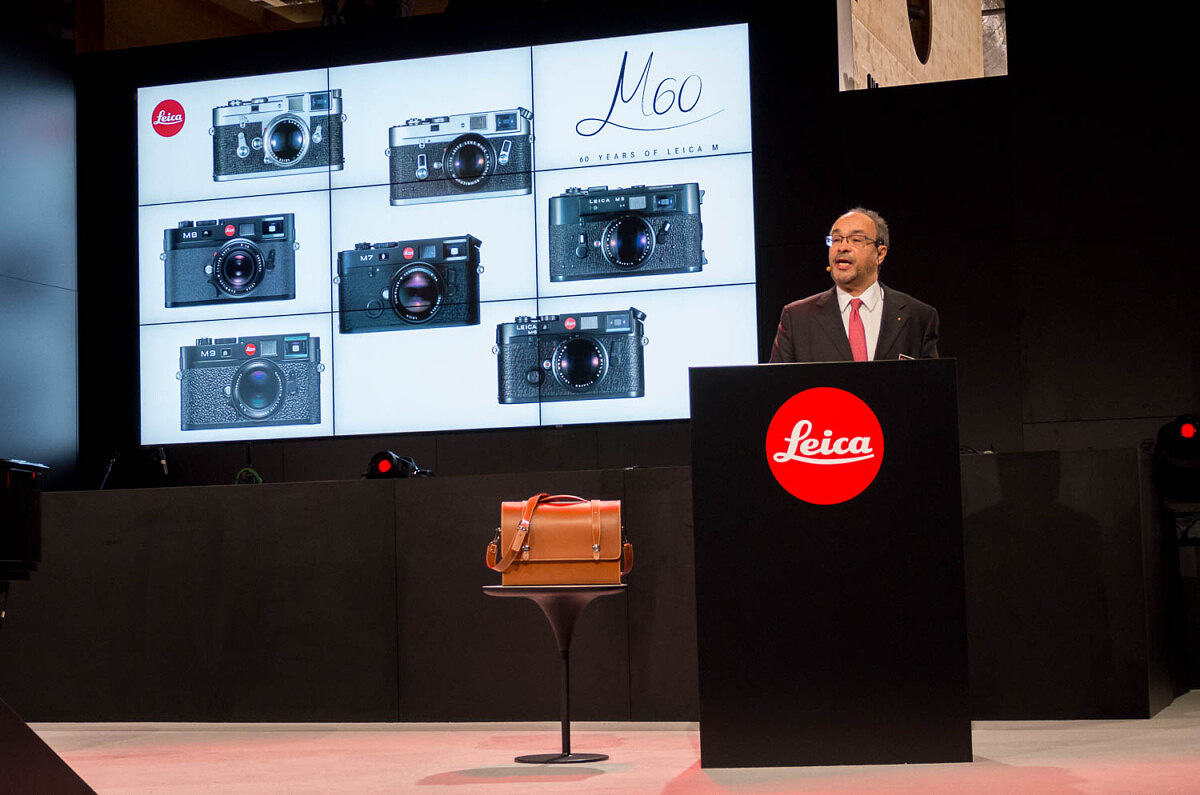
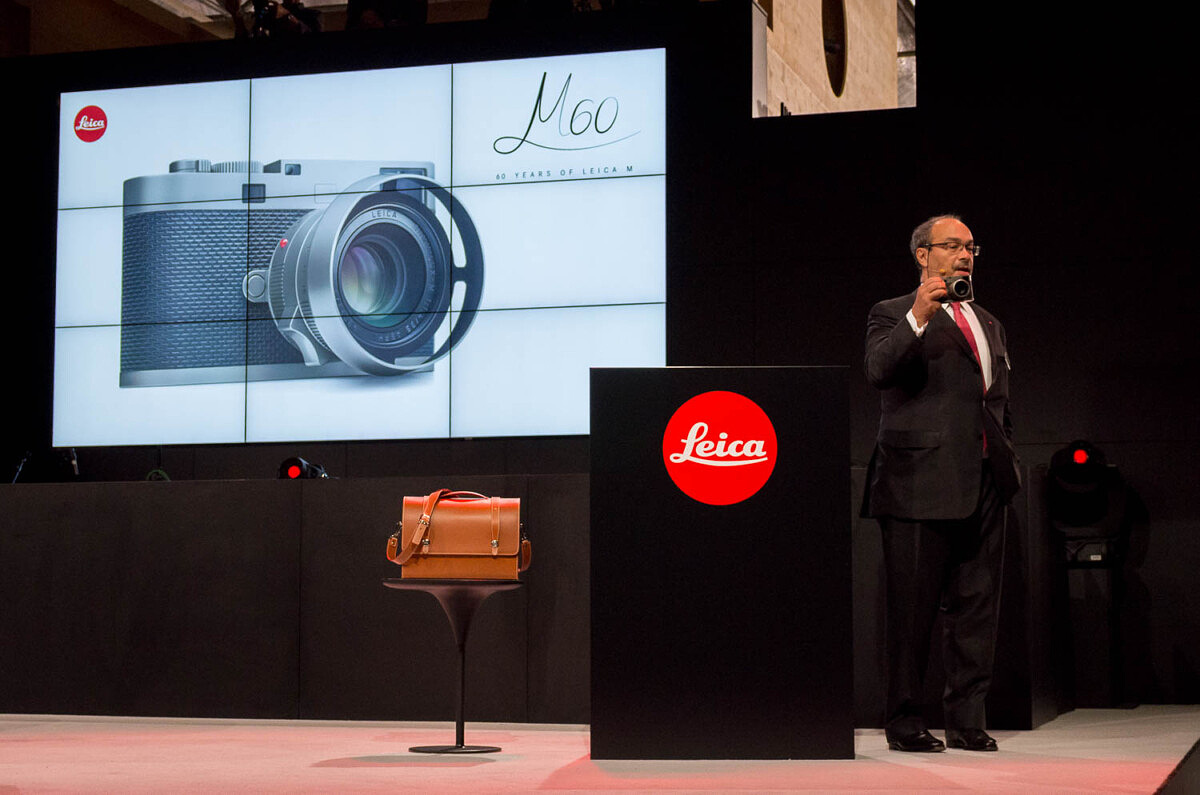
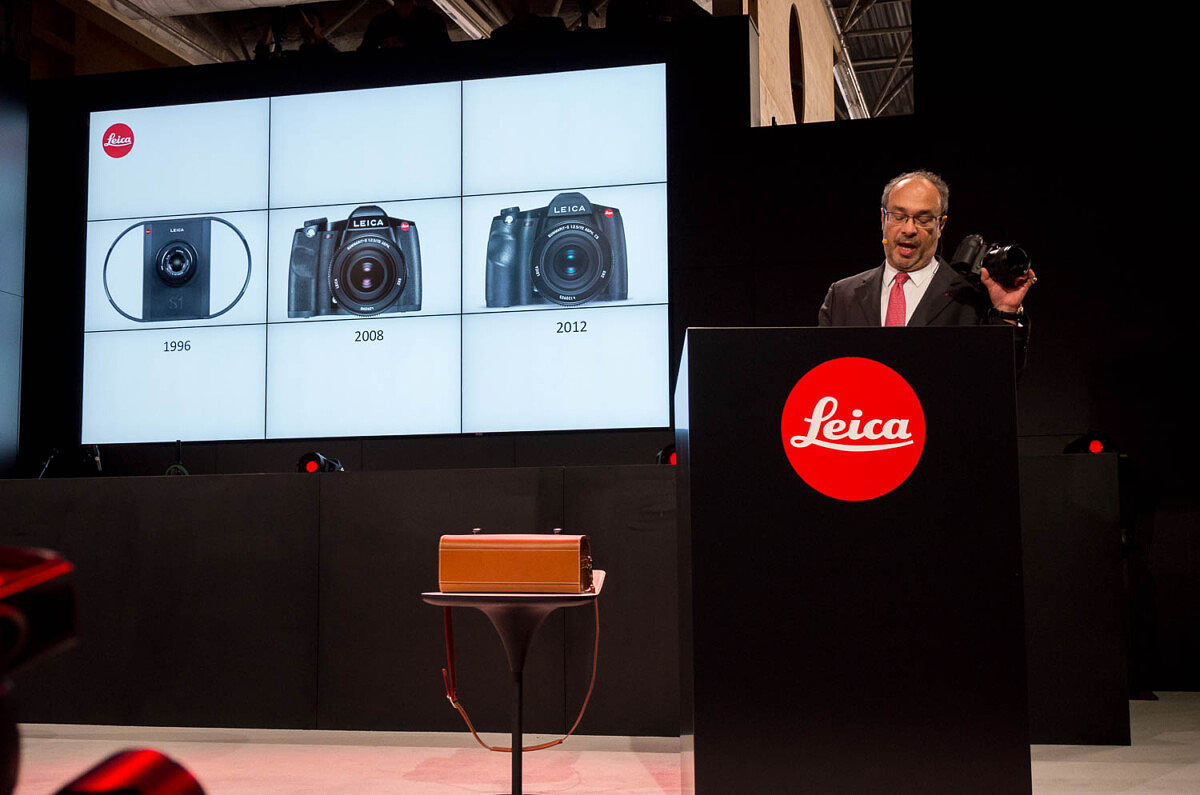

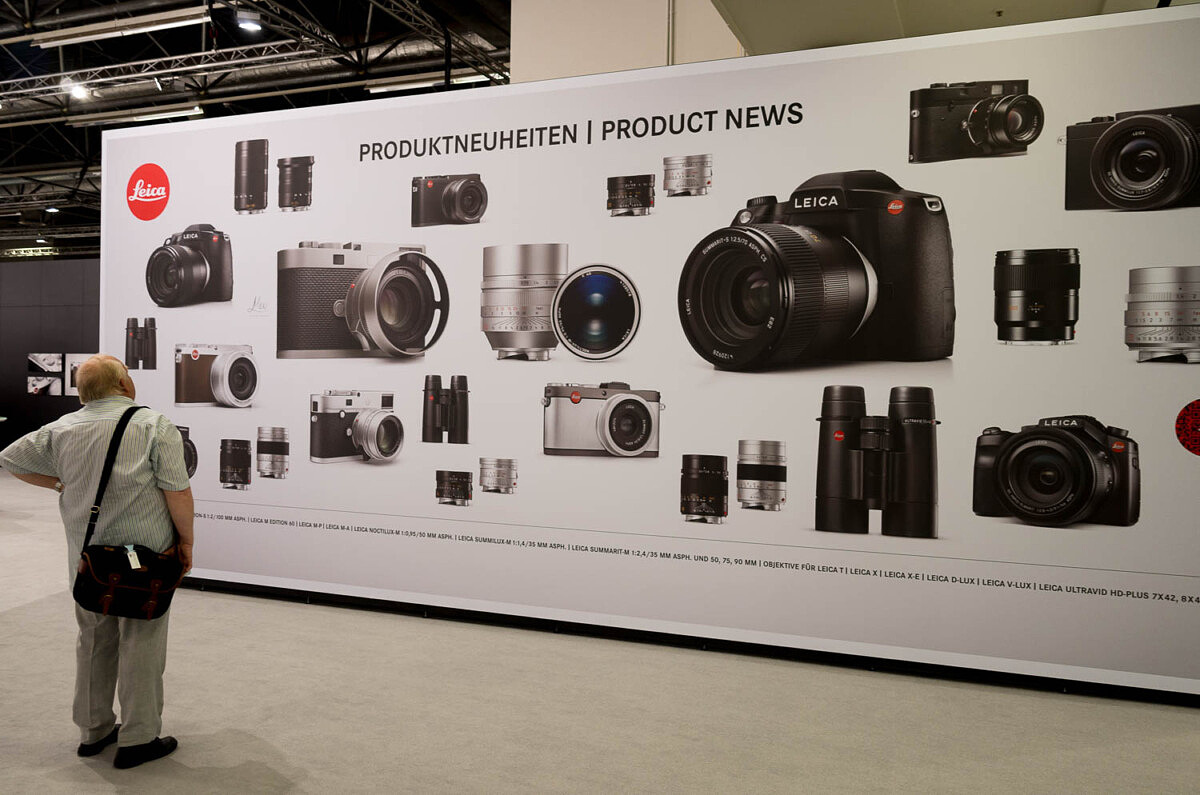
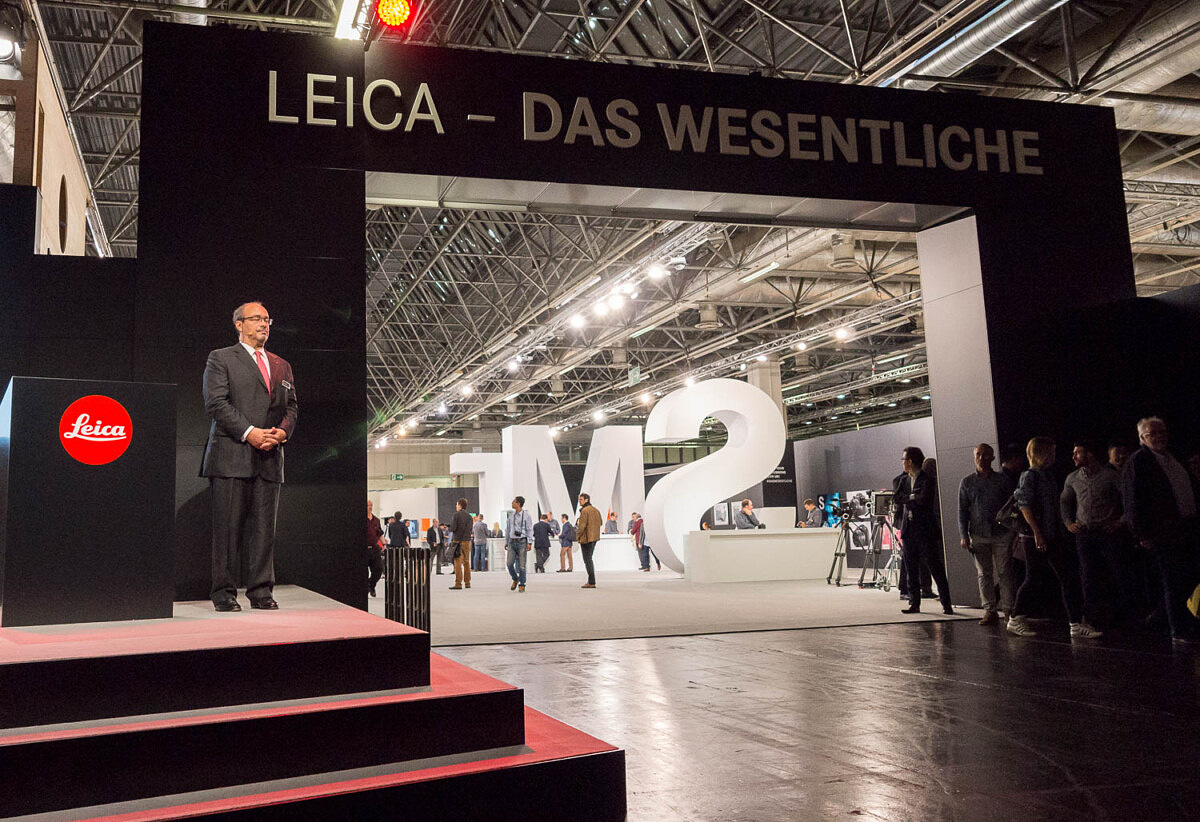
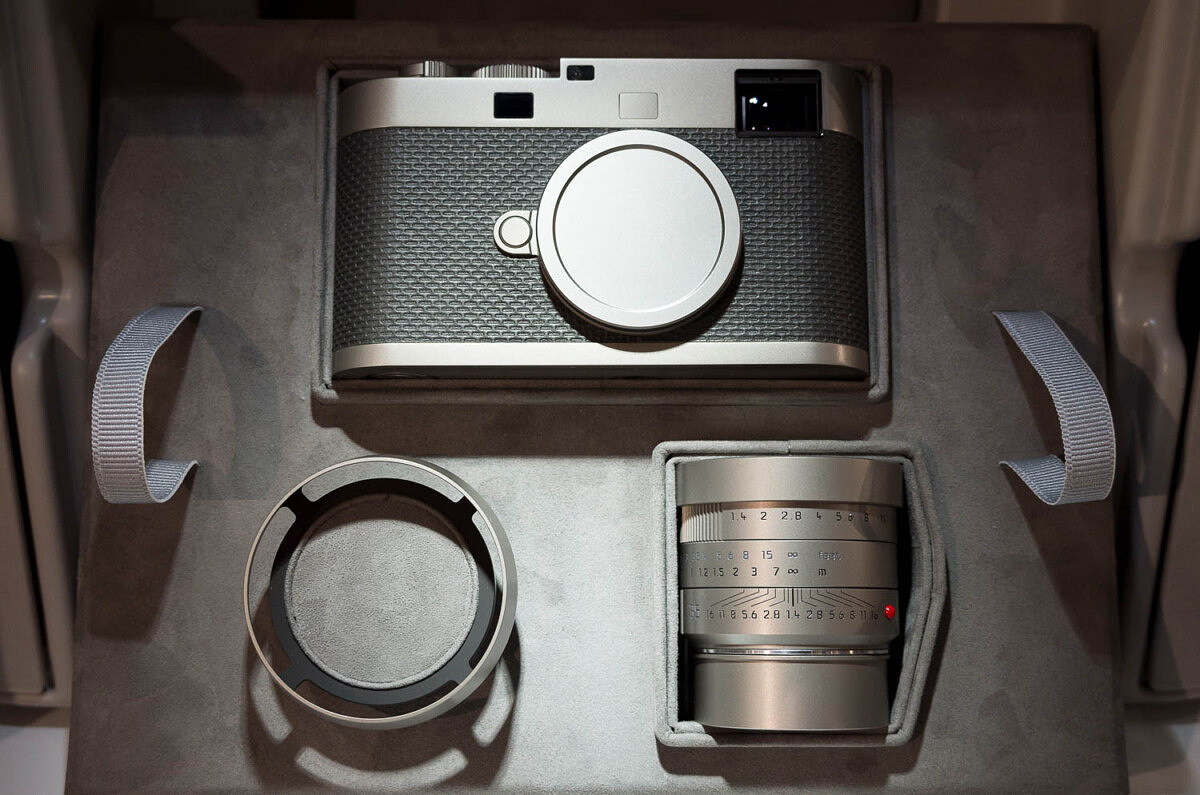
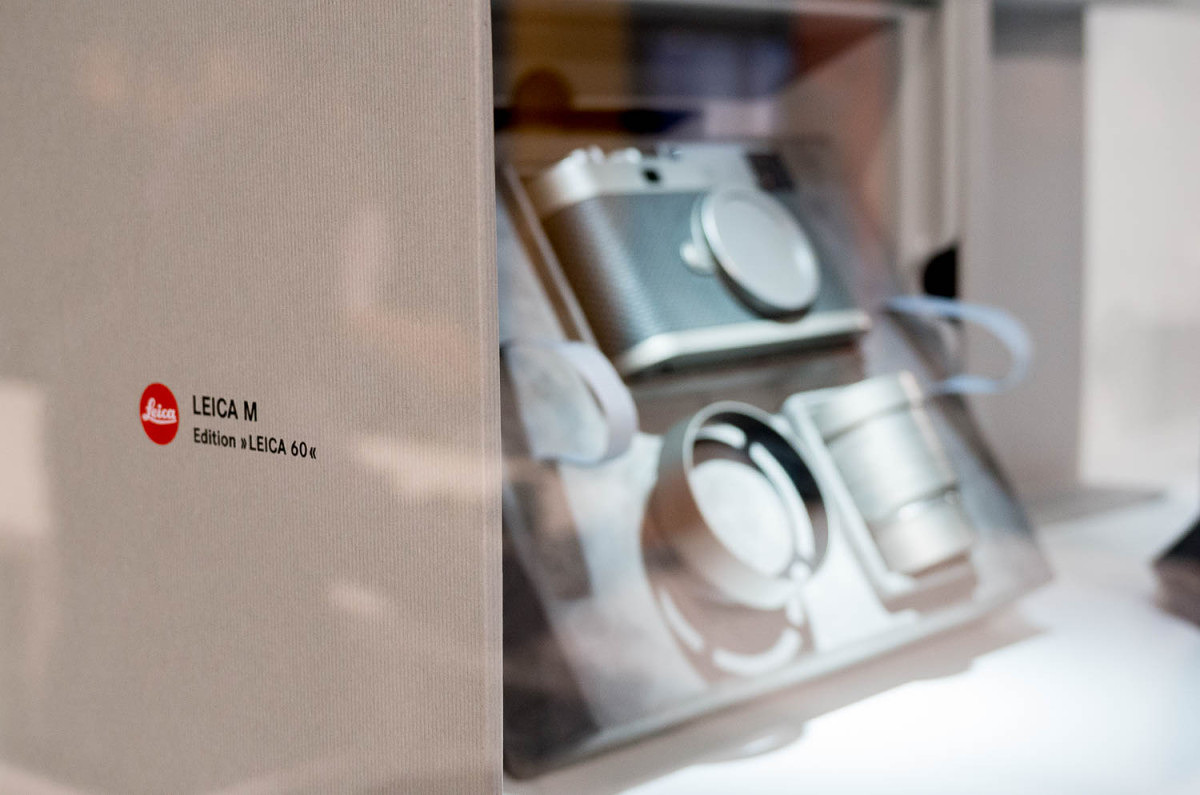

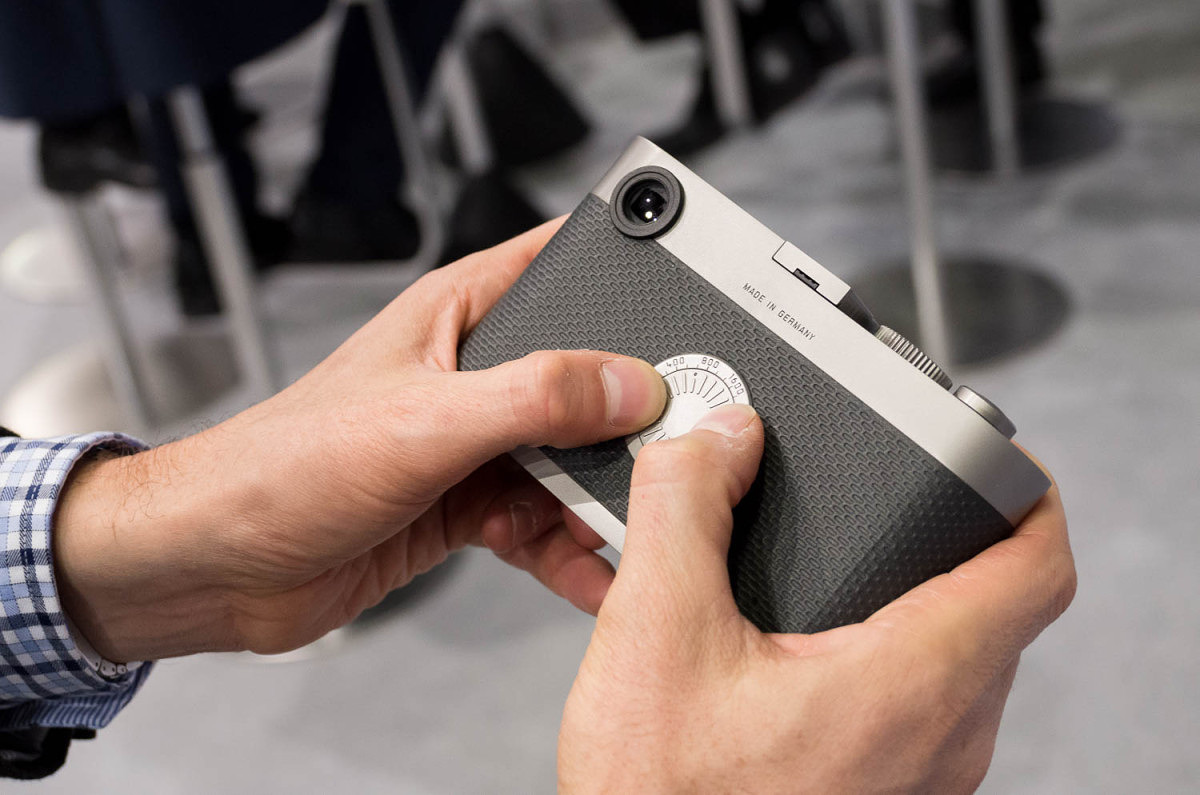
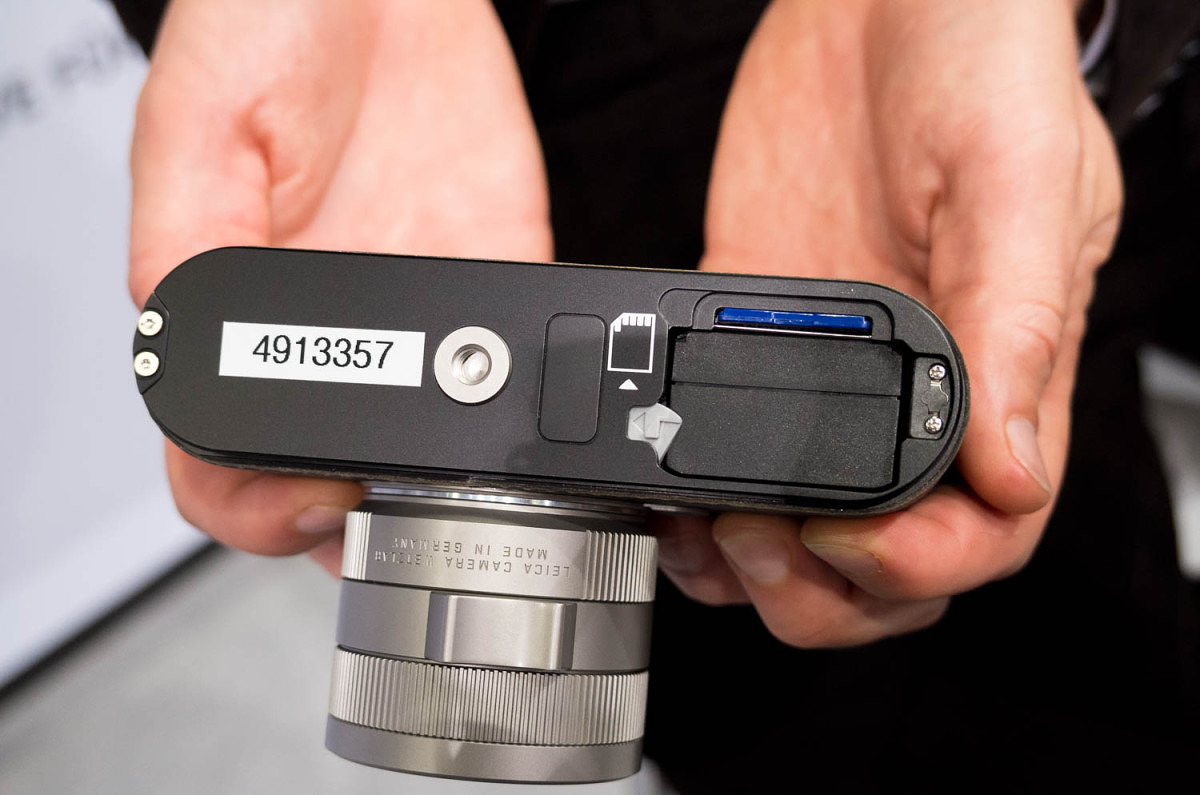

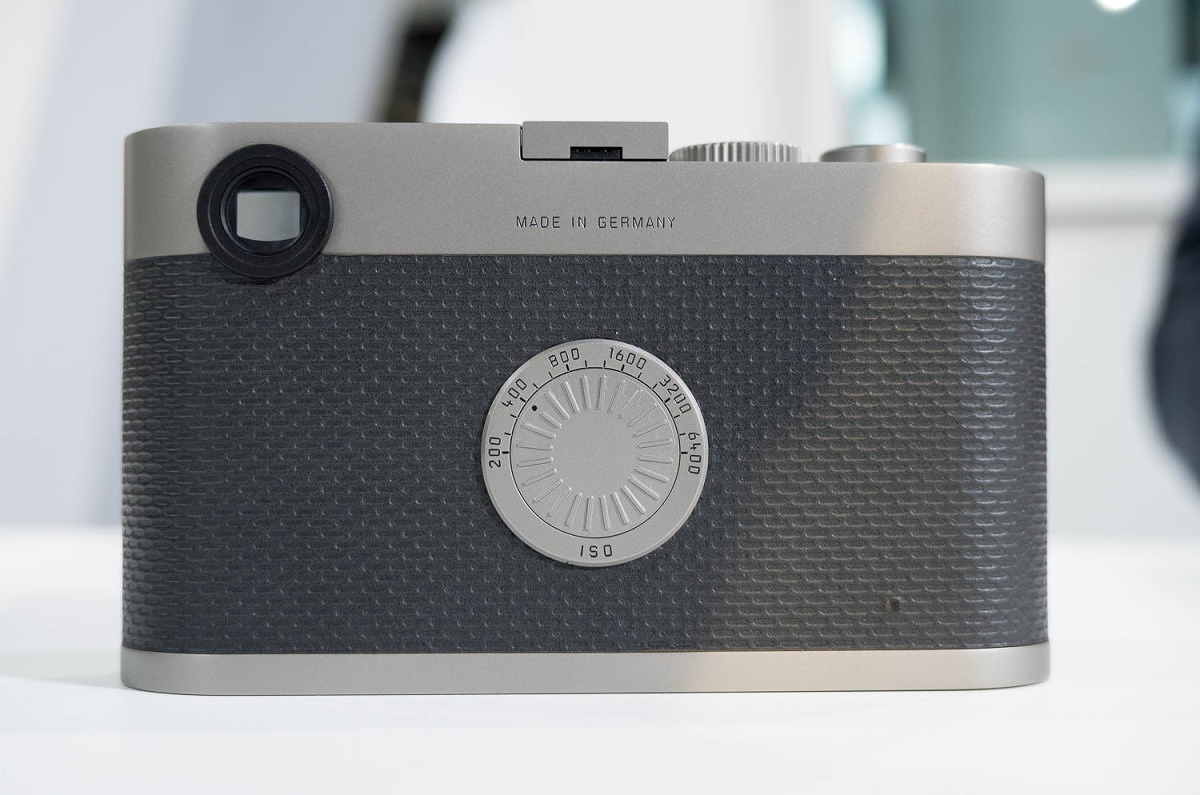
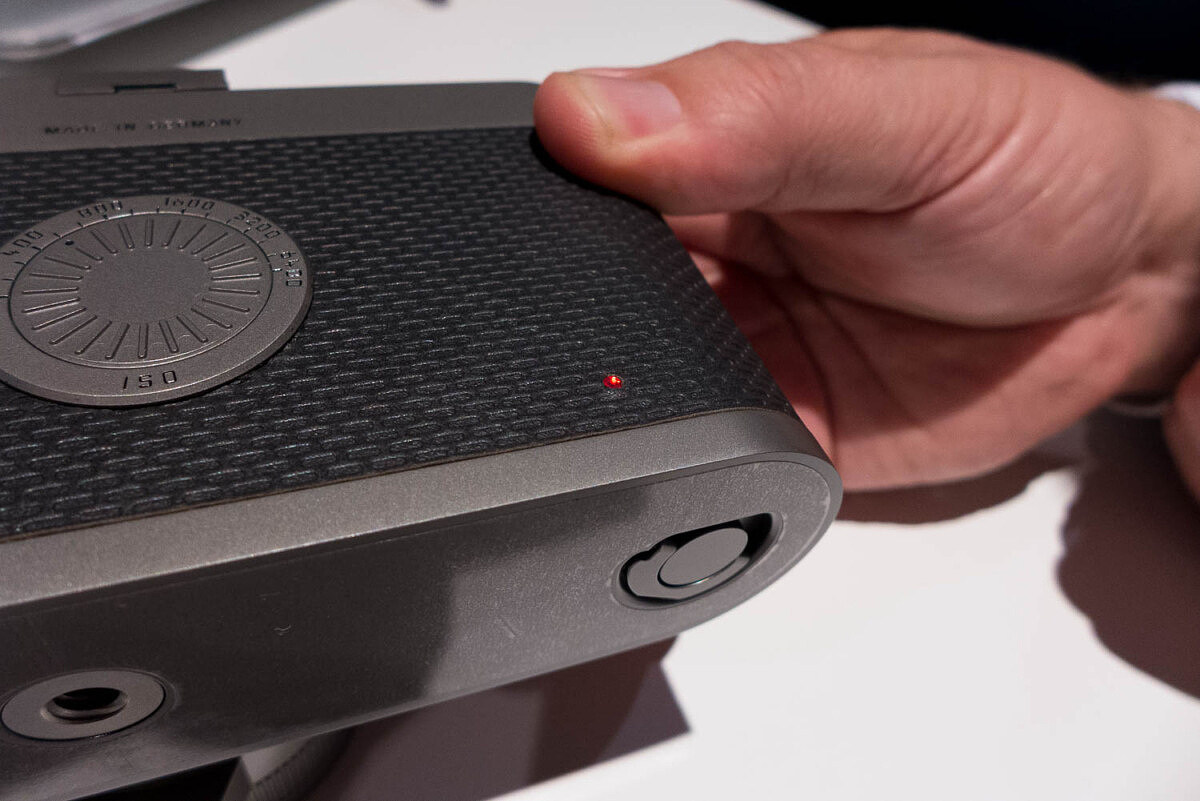
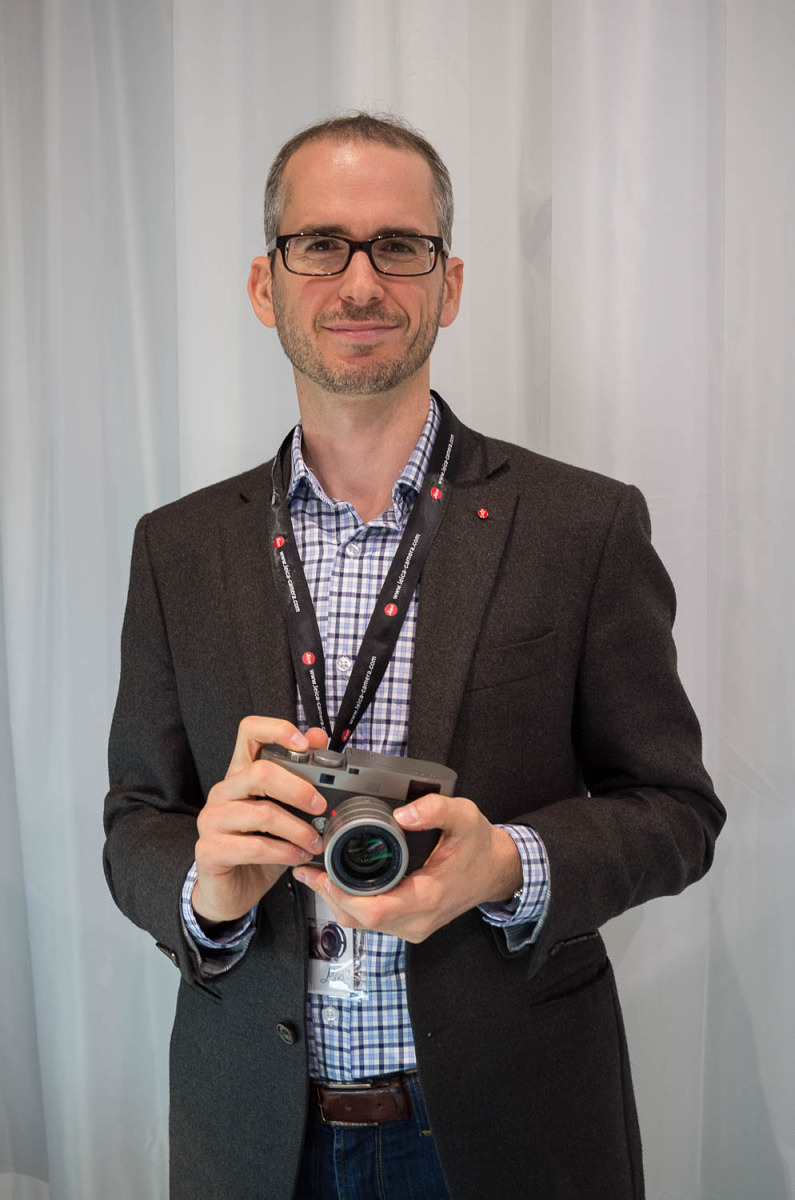


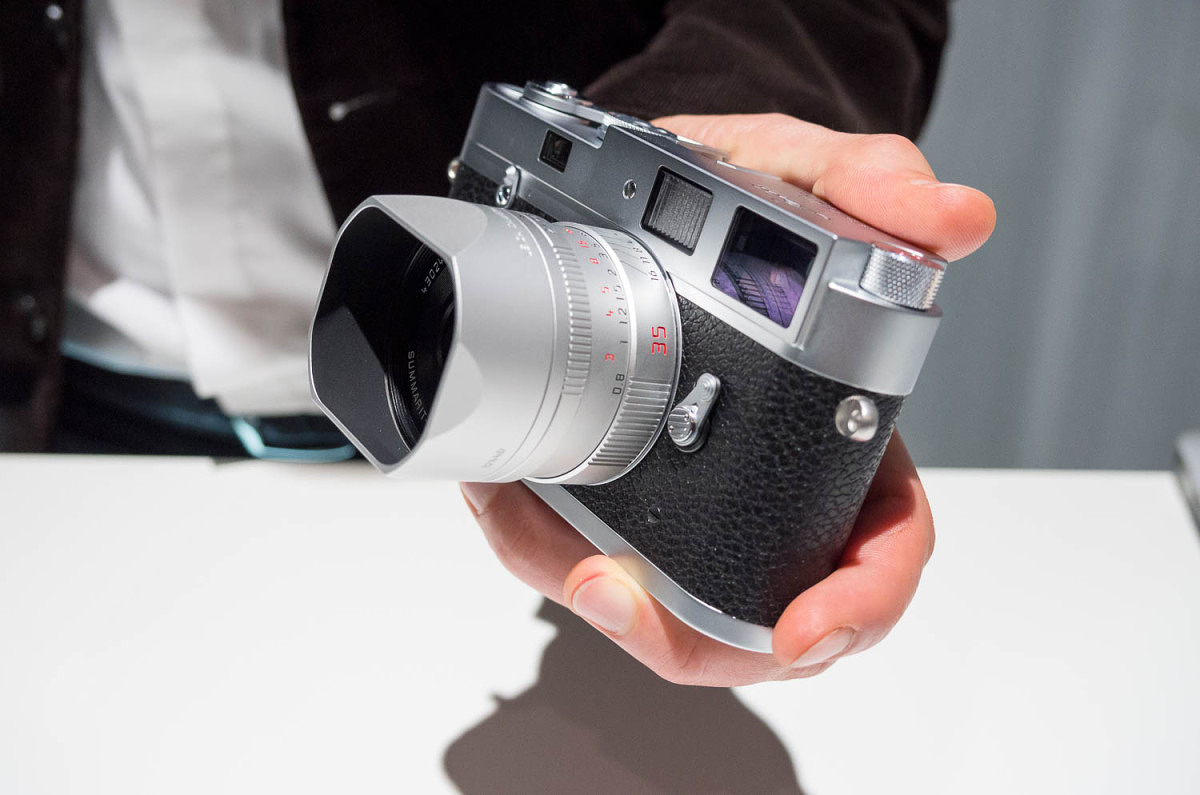
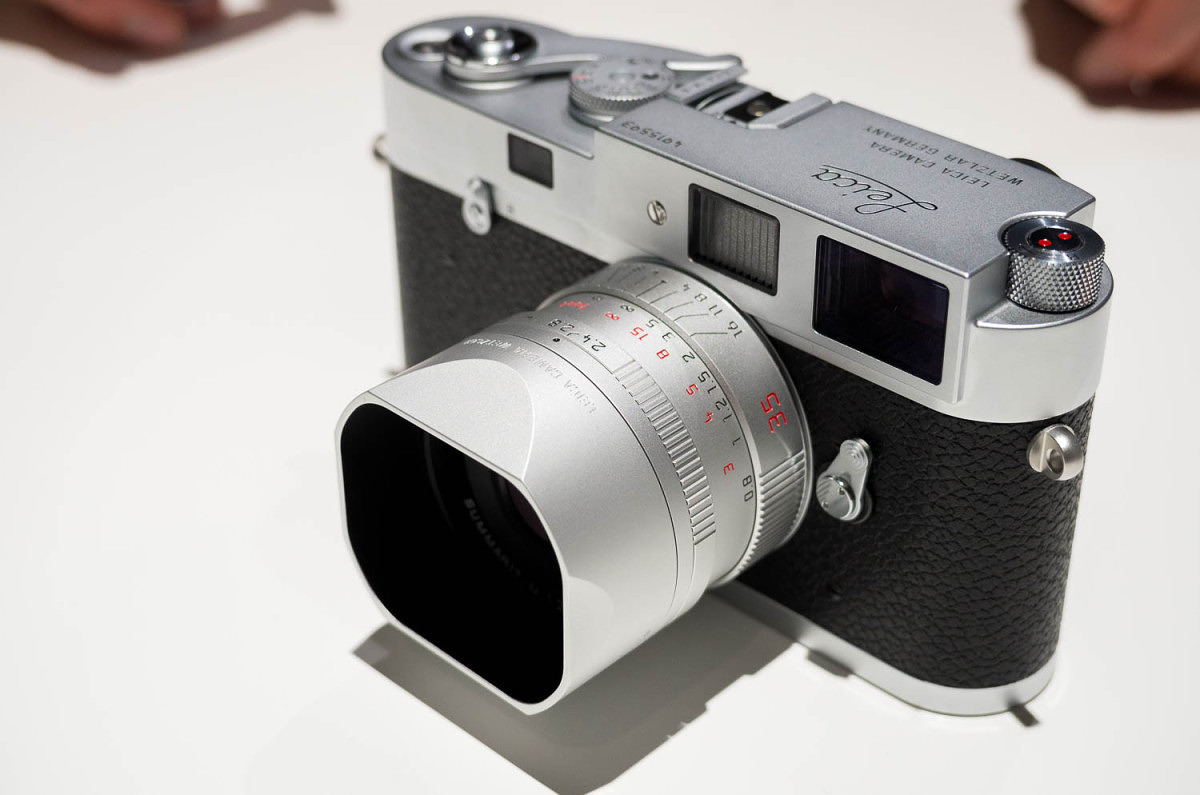
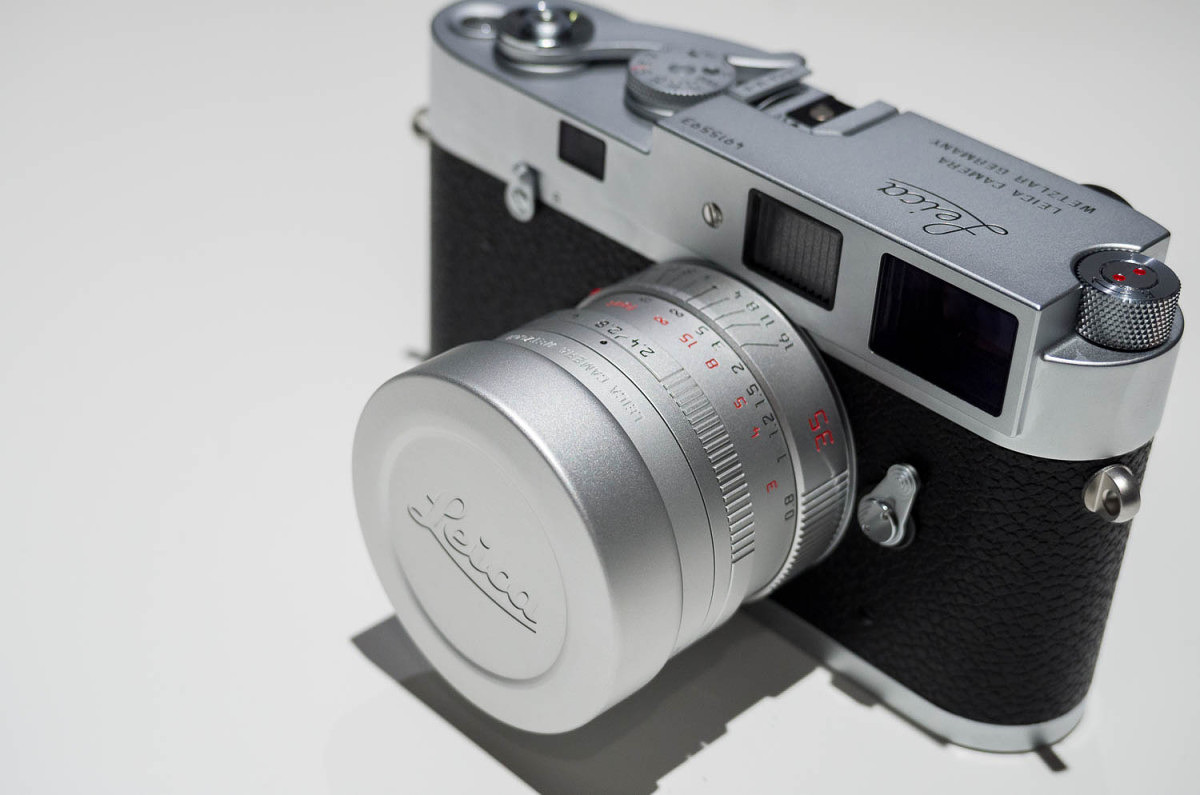
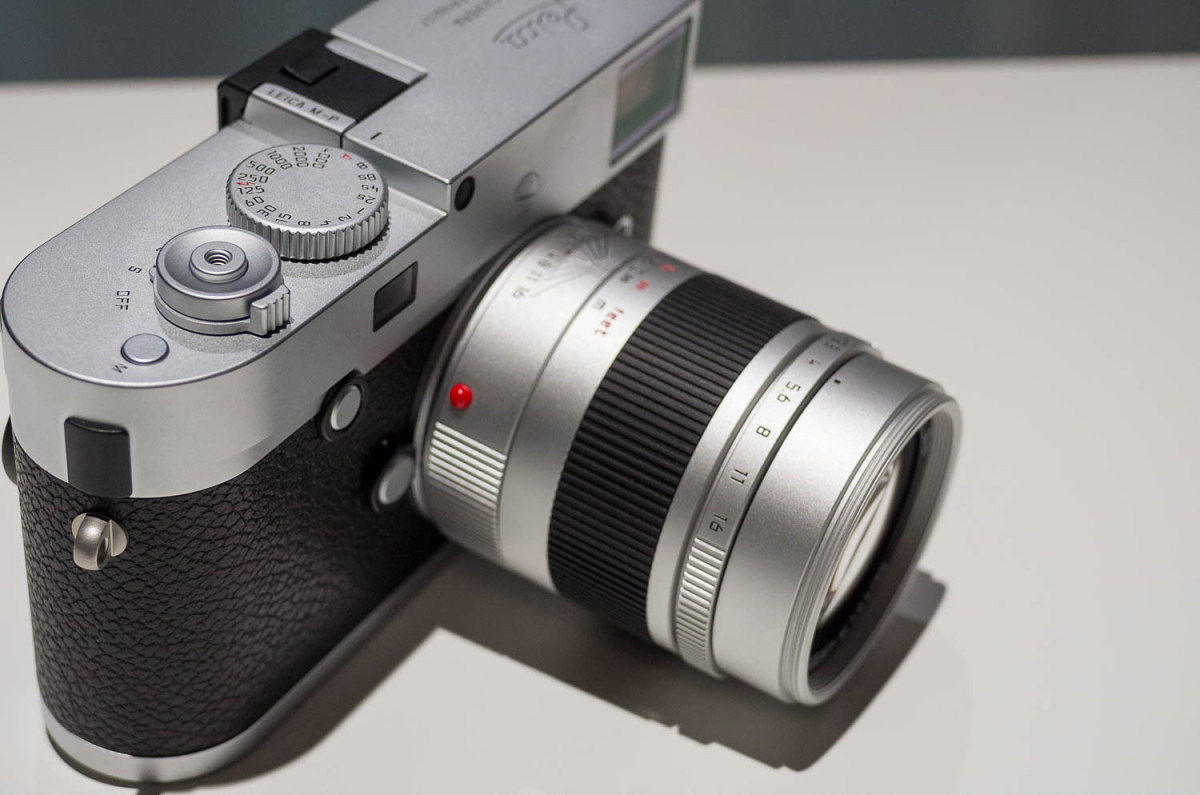
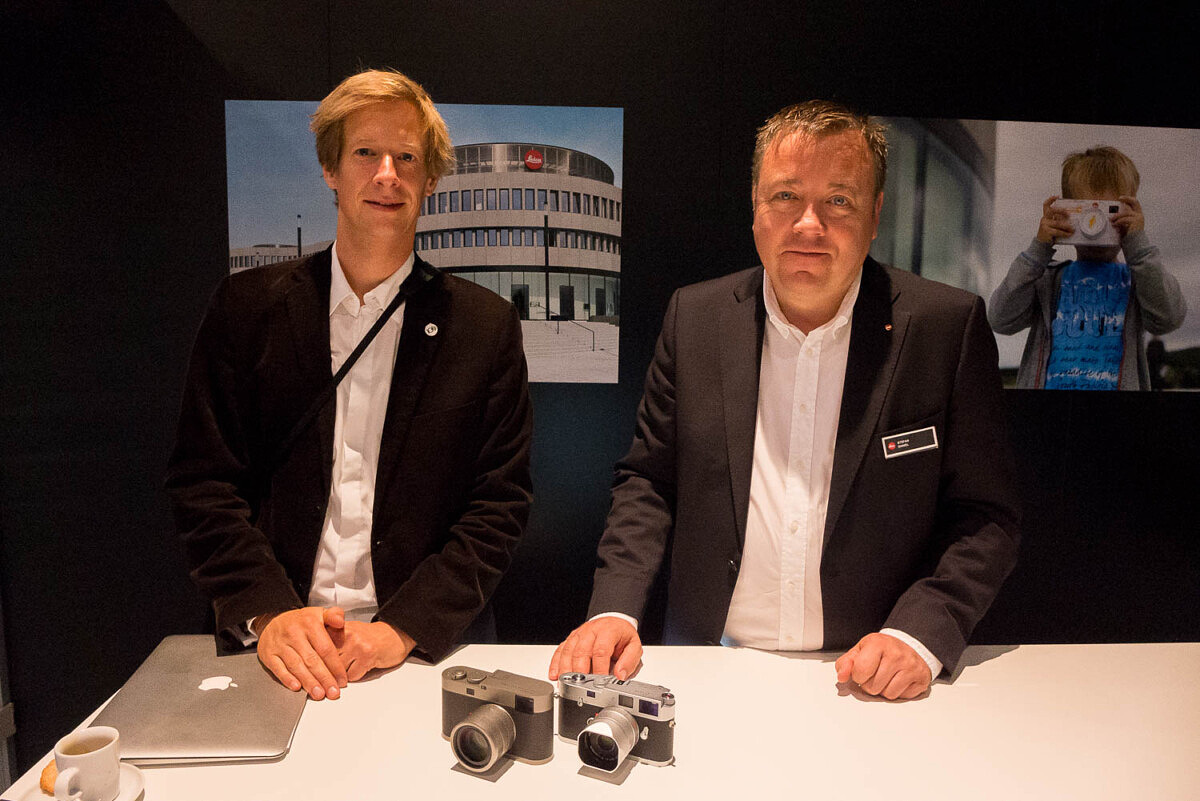
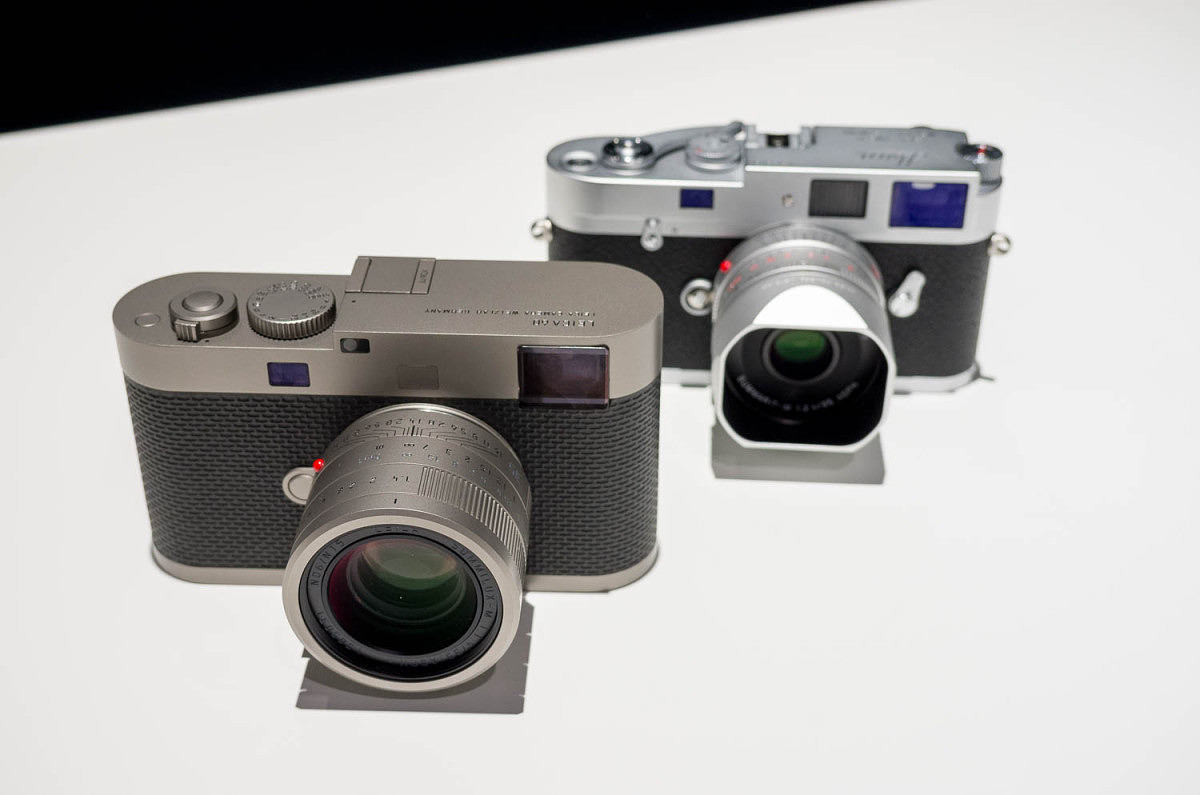
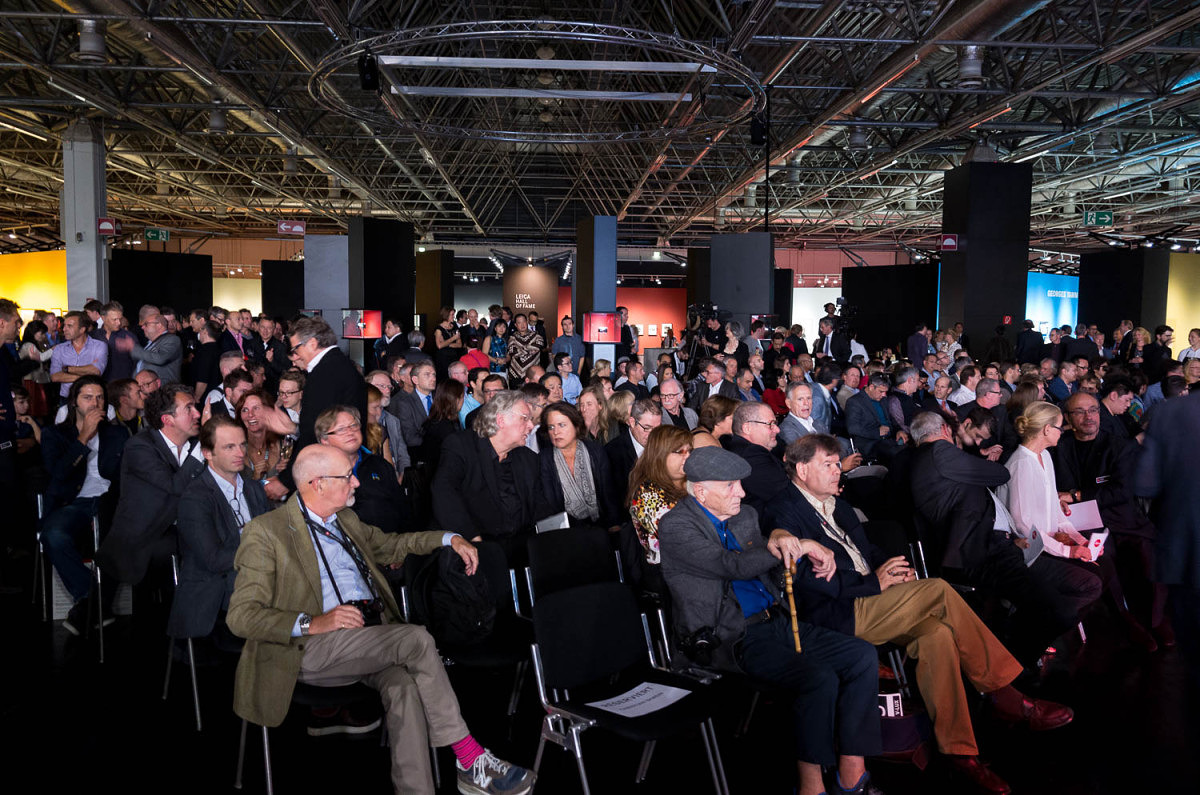
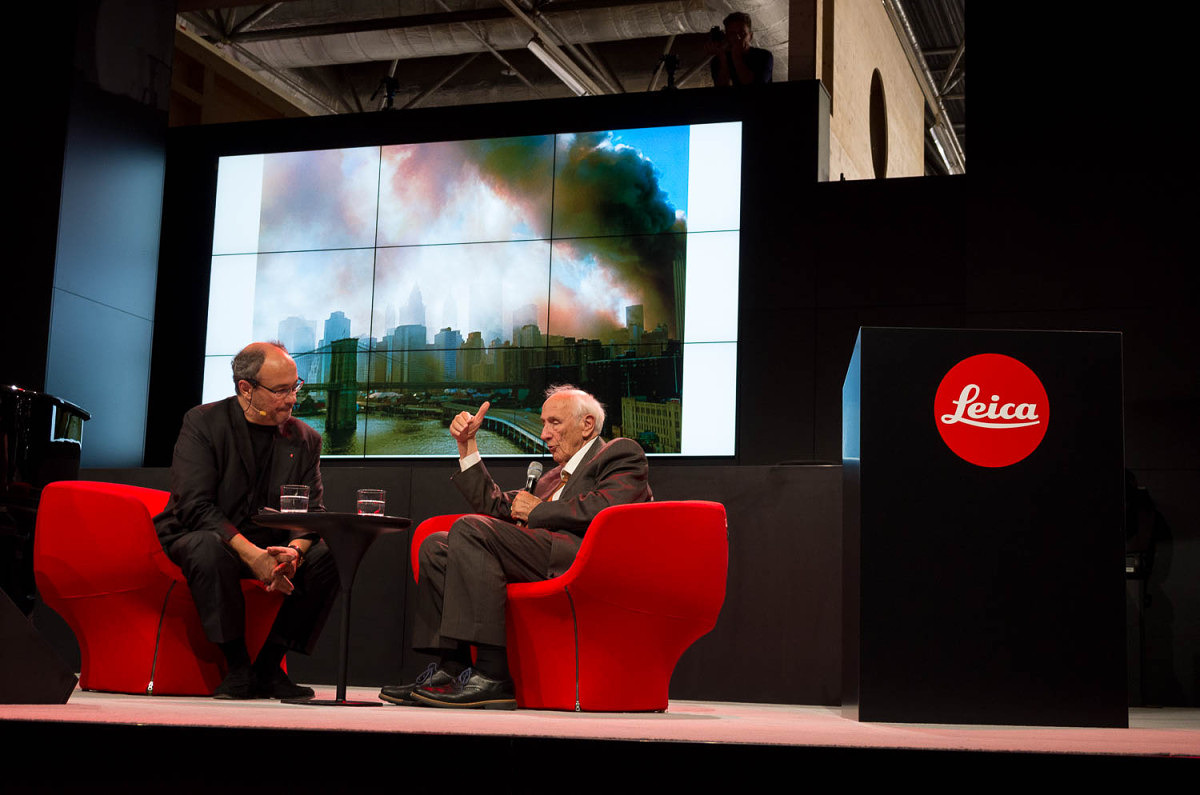

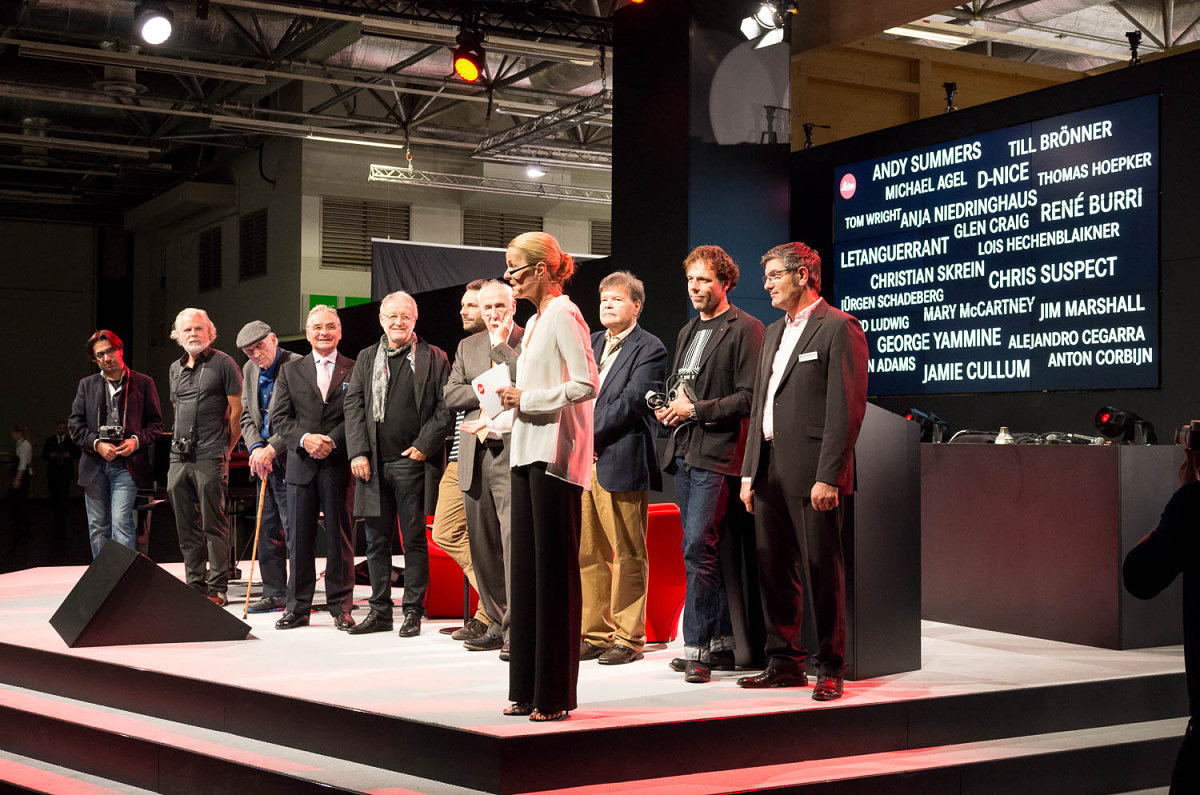
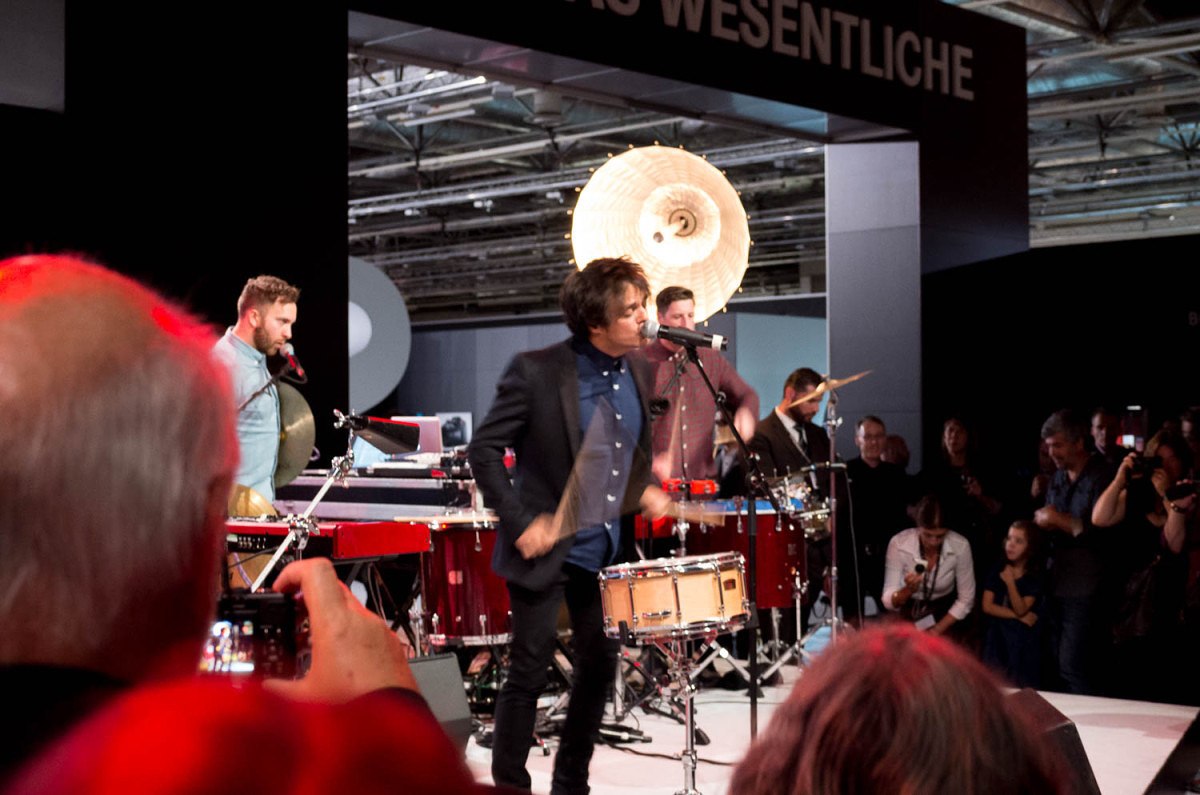
Great write-up David!! And the questions/answers also.
David, the part I find fascinating is the simplification of cameras comment, and the reason I love my M9. Could you ask if there is any push for simplification in the successor to the M240? Perhaps , my question is more request, so I am going to jump in with both feet. As features are added the complexity increases quickly, the M240 is feature rich and the complexity also followed. If anyone can simplify it is Leica, my frustration is the button pushing for playback with evf/screen firstly and the menu system secondly. A simplification could go something like this, attach the camera to a computer, allow choices of menu items visible/hidden. If I don’t use a menu item I could then hide it and never have to deal with it, thus simplifying. Of course simplifying initially adds complexity by creating one more process but the field shooting would be simplified by less menu choices. I am sure Leica could come up with a better solution, perhaps in a firmware update?
Daryl, this is an interesting idea. I’m happy to mention it tomorrow.
David,
Always nice to read your comments on this every two year show. No one else seems to capture the feelings, as well as the insight. The metal shades on the new lenses is most welcome, but I am having a difficult time understanding how the lens cap can fit over both the lens and the shade. I must be missing something?
I presently own many Leicas and would love to see a Leica without a screen as the M60 for the rest of us.
No screen, just dials and just the ISO setting on the back. IT would fit very nicely with my black MP film camera.
I think the Leica public would jump at such a camera. I would think that it could be thinner like the M3 or M-A and be priced under $5,000 USA. We could call it, “The Leica MO” The O standing for a Leica for the others.
The basis for such a camera would increase sales in lenses and other items. I love my M9-P and would not trade it for anything but a simplified MO would be ideal and affordable for chaps like myself.
Thank you, Harry Mueller
M3, M5, M7, M8.2, M9-P, MP
Lenses from 24 to 75mm.
The great cub reporter is at it again!
Your screed is a pleasure to read and I look forward to your upcoming report on the Leica S (typ 007).
Albert
Thanks Albert. Working on it now. So much information! I spent about two hours with the product managers earlier today.
David, thank you for the show report. Lots of stuff to cover. On a side note, which camera did you use for the photos of the event?
I’m guessing X Vario Mark 😉
Peter is correct. I used the X Vario (Typ 107) for almost all of the images in the article except for a few really close-up shots where I used the D-Lux 6.
I’m pretty sure that the event images were all taken at ISO 1600.
Nice little camera, that X Vario….
David…thanks for the well written and informative report. Enjoyed reading it and look forward to the next chapter.
Excellent write-up David!
Perhaps the new MM will be like the M 60, without the LCD.
And certainly agree with Mr. Jesko von Oeynhausen comment and I quote
“From a quality perspective, there is no need for improvement”.
[…] […]